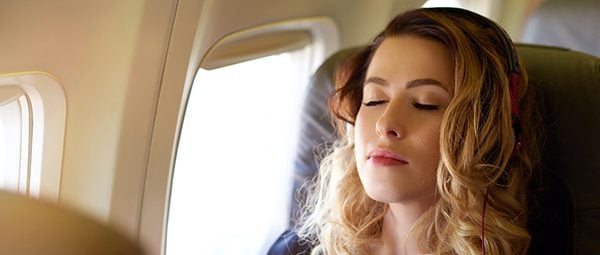How I Use Mindfulness to Make Budget Travel More Comfortable

Many or all of the products on this page are from partners who compensate us when you click to or take an action on their website, but this does not influence our evaluations or ratings. Our opinions are our own.
Anyone who has flown Spirit Airlines understands what the Buddha was talking about in the first noble truth: All life contains suffering.
Budget air travel has never been a particularly pleasant experience, but as more airlines cut legroom and other services in basic economy to compete with budget carriers like Spirit, it has become downright grueling.
There seem to be only a few options for avoiding the (literal) headache of budget travel:
Pay for upgrades.
Avoid budget airlines and basic economy altogether.
Grin and bear it.
However, over the past few years I’ve been using an alternative approach for dealing with the stress of traveling in less-than-ideal conditions. It’s not a new idea or strategy. In fact, it’s been around for a few millennia: mindfulness.
The middle-seat way
Mindfulness is not a religious practice, though it has its roots in Buddhist meditation. It was brought to the West and stripped of its religious trappings by a number of scientists and teachers, notably Jon Kabat-Zinn. His mindfulness-based stress reduction programs have become ubiquitous and well-studied training grounds for mindfulness students.
The core idea of mindfulness is simple: Paying full attention to the present moment, with acceptance. Yet despite its simplicity, mastering mindfulness requires decades of dedication. (I'm merely a beginner myself.)
Why is mindfulness so tricky? Because the present moment is exactly what many of us are trying to get away from, especially in uncomfortable situations like sitting in the middle seat. With a baby crying on one side and a thoughtless seatmate hogging the armrest on the other, most of us would rather pay attention to something — anything — other than the present moment. That’s likely why distractions like in-flight movies are so popular.
Mindfulness counterintuitively encourages you to engage directly with all experiences, both negative and positive. So instead of ignoring the pain in your knees caused by the 28-inch seat pitch, you should instead pay as much attention as possible to every nuance of the pain. Sound crazy?
Suffering = Pain x Resistance
The Zen meditation teacher Shinzen Young uses mathematical analogies for mindfulness practice. He suggests that suffering is the product of pain multiplied by resistance. It can therefore be reduced by either reducing the pain or reducing the resistance to that pain.
So when faced with a painful experience such as a seatmate who brought an egg salad sandwich, you have two options:
You can somehow convince your neighbor to put away the offending sandwich, or
You can reduce your resistance to the experience.
Those who have practiced some mindfulness meditation likely have a sense how this works. By simply paying attention to an experience nonjudgmentally, its negative aspects fall away naturally. This works for a surprising variety of negative experiences, including back pain, anxiety or in-flight turbulence.
For those who have never practiced meditation, it probably still sounds far-fetched. Unfortunately, simply reading this article is not going to turn you into a Zen monk on your next Frontier flight. That’s because mindfulness is a practice.
Your first in-flight meditation
Just as reading about weightlifting won’t make you any stronger, reading about meditation won’t make you any more mindful. The only way to understand mindfulness is to do it.
Meditation doesn’t need to be performed cross-legged in a mountain cave. Give it a shot on your next harrowing budget airline adventure. Here’s a variation of a practice I do at 30,000 feet.
Close your eyes and take a few longer, deep breaths. Pay attention to the sensation of breathing.
Spread your awareness out into your body. Notice how it's positioned right now. Are your shoulders hunched up to avoid touching your neighbor? Are your legs in a comfortable position?
If anything feels uncomfortable, bring your attention there. What is the pain your shoulders like? How does your skin feel in the airplane air? What does it feel like to suppress a cough?
Now bring your attention to sounds. On a plane, there are always sounds. Try to pay attention to them without judgment. If a kid is screaming, just listen to the scream exactly as it is without reacting to it. Or, if you can’t help but react to it, notice the feeling of reacting it. Do you feel tense or upset? What is that like?
Open your eyes and notice whether you feel any different than when you started.
Expect some bumps
Don’t be surprised if your first attempt at in-flight mindfulness doesn’t go smoothly. In fact, expect it to be difficult. Just as exercise makes your muscles sore when you’re out of practice, mindfulness can feel overwhelming or uncomfortable at first.
Stick with it.
I often tell people that mindfulness is a superpower — not because it gives you the ability to change your surroundings, but because it lets you deal with whatever is happening in your surroundings.
One surprising side effect of my meditation practice has been monetary. I don’t splurge on “comforts” like premium cabin seating or expensive hotels as often because I’m better able to tolerate — and enjoy — more difficult experiences.
That said, no amount of mindfulness seems to help when people crowd the boarding area before their group has been called. I just hate that.
Planning a trip? Check out these articles for more inspiration and advice: Find the best travel credit card for you Snag these hotel loyalty perks, even if you’re disloyal Earn more points and miles with these 6 strategies
Chase Sapphire Preferred® Card
Travel
Dining
🔥 Huge highest-ever bonus on NerdWallet's 2025 Best All-Purpose Travel Rewards Card is back. Don't miss your rare chance to: Earn 100,000 points when you spend $5,000 on purchases in the first three months. That's worth at least $1,250 toward travel booked through Chase.


